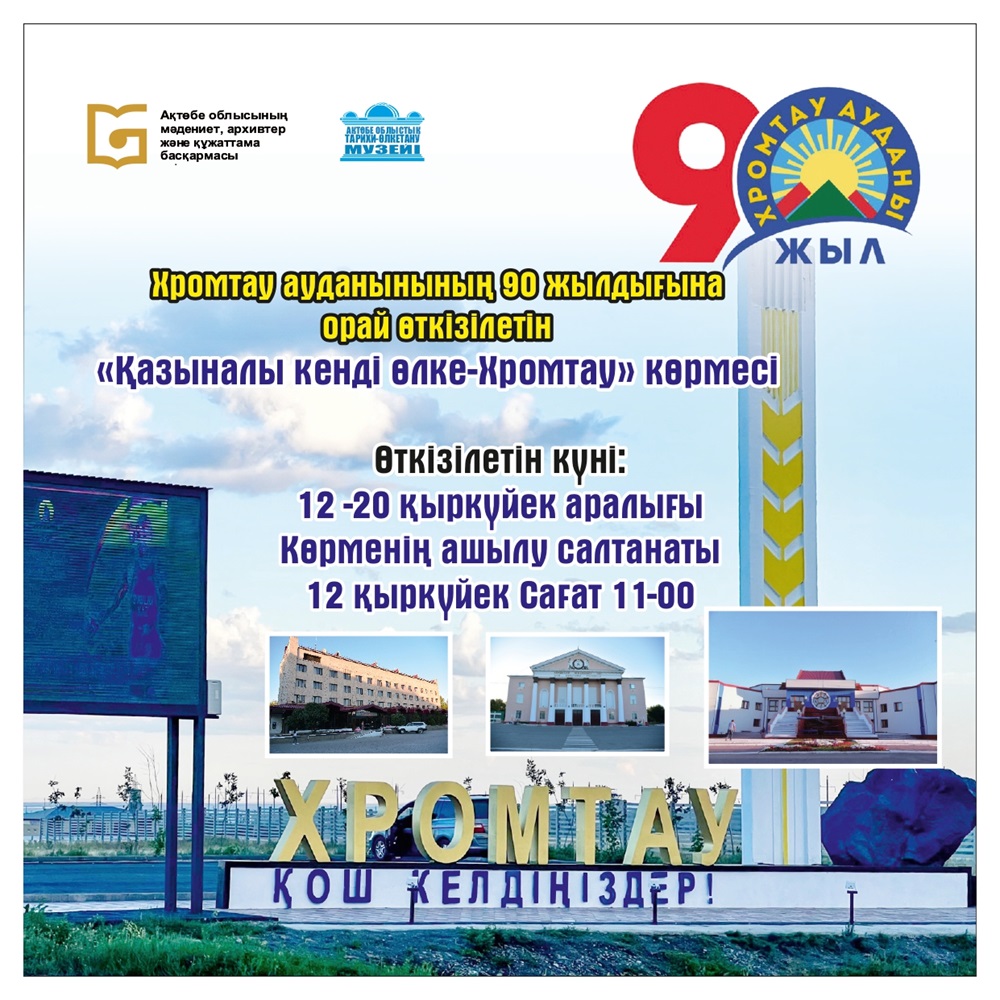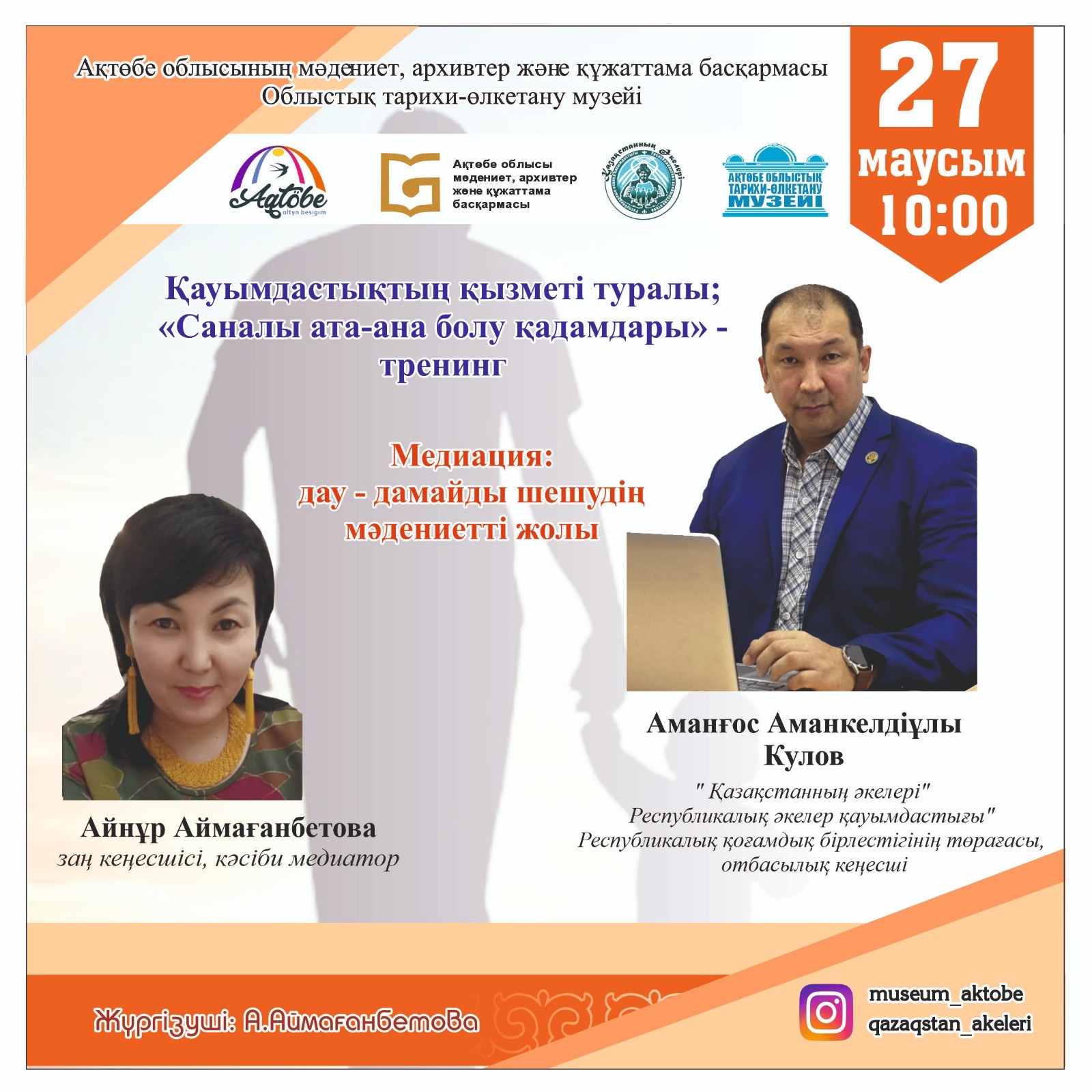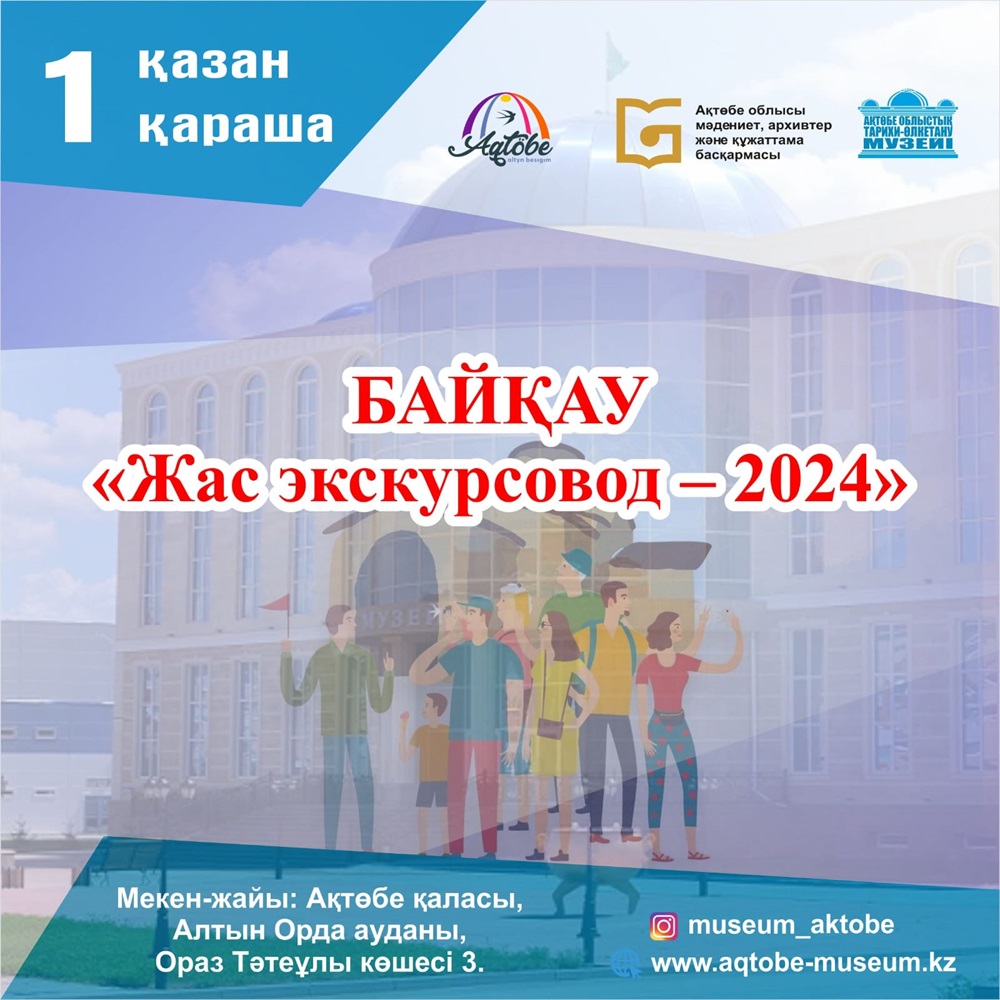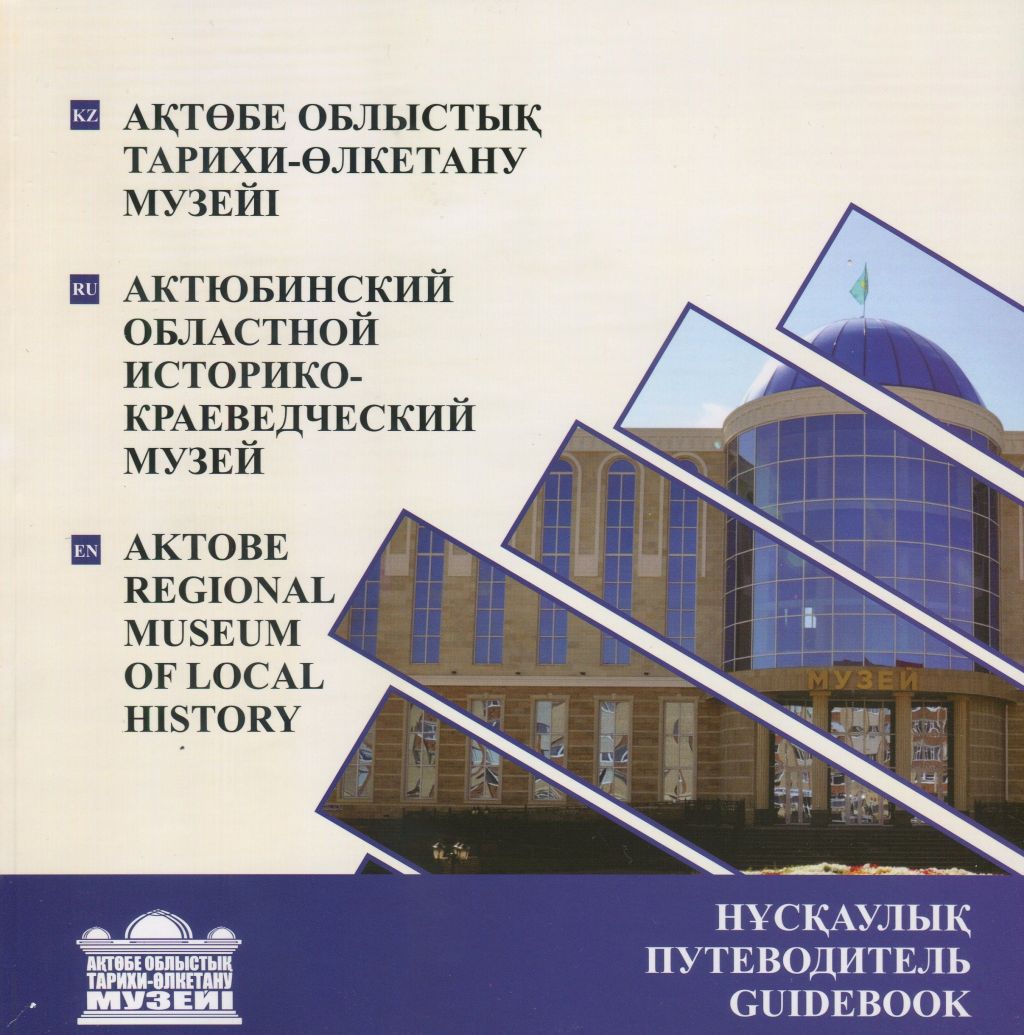According to archival documents, the creation of the Aktobe regional Museum of local history dates back to August 25, 1929, when an exhibition dedicated to the history of the region was held in Aktobe. The Aktobe Department Of the society for the study of the region attached special importance to this exhibition, which had a positive impact on the creation of a future Museum in the regional center. The first Museum started functioning as a small school Museum. In the documents, it is listed as a "Local history Museum" or "District Museum of local lore", referring to the local government system.
The founder and first Director of the Museum, was David Trofimovich Temushka. During his time as head of the Museum from 1929 to 1945, he made a great contribution to its formation and development.
From 1929 to July 1934, the local history Museum occupied a small and unsuitable 6x6 sq.m. space on the outskirts of the city.  In 1934, the institution moved to the former mission Church school building. In December of the same year, the Museum moved to the site of the former office "Trade syndicate" on Lenin street. In 1946, by decision of the city Executive Committee, the building where the local history Museum was located was transferred to the labor reserve for training personnel specialists. After that, the team, temporarily located on the second floor of the House of culture, in September was moved to the building on Komsomolskaya street, 22. in 1962, the Museum moved again to the building on Frunze street, 62.
In 1934, the institution moved to the former mission Church school building. In December of the same year, the Museum moved to the site of the former office "Trade syndicate" on Lenin street. In 1946, by decision of the city Executive Committee, the building where the local history Museum was located was transferred to the labor reserve for training personnel specialists. After that, the team, temporarily located on the second floor of the House of culture, in September was moved to the building on Komsomolskaya street, 22. in 1962, the Museum moved again to the building on Frunze street, 62.
 In 1965, the staff of the regional Museum was offered the building of a former two-story hotel located in the city center. The total area of which was 848.6 sq. m., 563 sq. m. Were allocated to create a thematic exhibition. In June of this year, Rakhila Sarsenovna Sarsenova is appointed director of the Museum. Thanks to the experience gained earlier in the public service, she was able to solve the problematic issues facing the Museum staff in the shortest possible time. The new Manager had to solve the problems of correcting the financial situation, as well as activating the work of the Museum. Together with scientific staff, Rakhila Sarsenovna actively contacted the residents of the city and the region, began to collect exhibits for the new emerging exhibition. Major repairs to the building were completed on December 30, 1965. The design of the Museum's exposition was entrusted to the Orenburg creative and production workshop.
In 1965, the staff of the regional Museum was offered the building of a former two-story hotel located in the city center. The total area of which was 848.6 sq. m., 563 sq. m. Were allocated to create a thematic exhibition. In June of this year, Rakhila Sarsenovna Sarsenova is appointed director of the Museum. Thanks to the experience gained earlier in the public service, she was able to solve the problematic issues facing the Museum staff in the shortest possible time. The new Manager had to solve the problems of correcting the financial situation, as well as activating the work of the Museum. Together with scientific staff, Rakhila Sarsenovna actively contacted the residents of the city and the region, began to collect exhibits for the new emerging exhibition. Major repairs to the building were completed on December 30, 1965. The design of the Museum's exposition was entrusted to the Orenburg creative and production workshop.
 On June 6, 1967, the Grand opening of the regional Museum of local history was held, which was attended by the first Secretary of the Central Committee of the Communist party of Kazakhstan Dinmukhamed Akhmetovich Kunaev.
On June 6, 1967, the Grand opening of the regional Museum of local history was held, which was attended by the first Secretary of the Central Committee of the Communist party of Kazakhstan Dinmukhamed Akhmetovich Kunaev.
In the 60-70s of the last century, the archaeological science of Kazakhstan achieved new successes. Funds of regional museums will be replenished with new exhibits that reveal the ancient history of the region. Thanks to the activity of employees and the interest of the population in the regions, professional specialists began to study monuments that are under threat of extinction and are important for science.
The famous scientist V. S. Sorokin in 1955 conducted research of monuments of the Aktobe region in the basin of the rivers Ilek, Khobda, Emba (Zhem), Kargaly and Or, studied materials on the material culture and economy of the population of the bronze age. In the 1970-ies in the course of three field seasons of major scientific studies conducted Karatau squad of the South Kazakhstan complex archaeological expedition of Institute of history, archaeology and Ethnography of Academy of Sciences of (head candidate of historical Sciences M. K. Kadyrbayev). As a result of excavations of the burial mounds of Besoba, Syntas, Kamissay and Zhalgyzoba, gold products and household items made by Sarmatian masters were found, which added to the Museum's Fund.
In connection with the increase in interest in the discovered archaeological artifacts, since December 1974, a circle "Young archaeologist"will be created in the regional Museum of local history for schoolchildren of the city. The head of the circle is a member of The scientific Council of the regional Museum, an excellent student of the geological branch of the USSR V. V. Rodionov.
In August 1980, Ryszhan ilyasovna Ilyasova was appointed Director of the regional Museum of local history. On September 10, 1981, the regional Museum was closed for major repairs. On July 5, 1985, the Halls of the Department of nature and the pre-Soviet era were opened, and a year later the hall of the Soviet society began to receive its visitors. As a result of research work, the regional Museum staff reorganized the exposition dedicated to the formation and promotion of the heroism of the 101st national rifle brigade and the 312th rifle division, which contributed to the victory in the great Patriotic war. The thematic exposition has been expanded with personal belongings of hero of the Soviet Union cosmonaut V. I. Patsaev.
With the Declaration of independence of our country, the study and research of national history began. In 1992, on the eve of the 325th anniversary of Tam Yeset Kokiuly, changes were made to the exposition of the regional Museum and new design plans were drawn up. This year, the first hall "batyrs of the steppe" was opened.
Aktobe regional Museum of local history in 1999 became a member Of the international Association "Open Museum" in Krasnoyarsk, since 2003 – the International Council of museums "ICOM of Kazakhstan".
 From 2003 to 2010, the regional Museum was headed by the honored worker of culture of the Republic of Kazakhstan Yerkin Zholmurzinovich Kurmanbekov. Over the years, he has organized educational events, scientific conferences, and expeditions dedicated to the memory of historical figures.
From 2003 to 2010, the regional Museum was headed by the honored worker of culture of the Republic of Kazakhstan Yerkin Zholmurzinovich Kurmanbekov. Over the years, he has organized educational events, scientific conferences, and expeditions dedicated to the memory of historical figures.
In 2013, the Regional center of history, Ethnography and archeology was attached to the Museum. This event contributed to the development of research work of the Museum staff.
In 2013, the Director of the Museum became a young and energetic Meiram Nurlanovich Duisengali, who puts all his knowledge and efforts to the development of the Museum business. For many years, one of the main problems of the Aktobe regional Museum of local history was the need for a new building. In this situation, with the direct support of the regional leadership, the Foundation of a new standard building will be laid in the new district of the city, taking into account modern requirements for Museum business.  On November 14, 2018, the official opening of the new Museum building took place. The Grand opening of the center of culture began with the presentation of the mobile stock exhibition "N. Nazarbayev: epoch, personality, society", organized by the Library of the First President of the Republic of Kazakhstan – the Leader of the Nation.
On November 14, 2018, the official opening of the new Museum building took place. The Grand opening of the center of culture began with the presentation of the mobile stock exhibition "N. Nazarbayev: epoch, personality, society", organized by the Library of the First President of the Republic of Kazakhstan – the Leader of the Nation.
Today, the Museum has ten halls. The total area of the new building is 4360.4 sq. m., of which the area of exposition and thematic exhibition halls is 1425.8 sq. m. and the area of the Museum Fund is 341.23 sq. m. the new Museum has workshops, a scientific library, storage rooms for the Fund's exhibits, creative rooms, etc. Large-scale led screens, an interactive virtual book, multimedia equipment, a virtual holographic complex, information kiosks and other technological innovations were launched in the exhibition halls.
Currently, the Aktobe regional Museum of local history continues the traditions of the past years, while making innovations dictated by time. For the development of exhibition, research work, establishes contacts with many museums and research institutions in the country and abroad.











